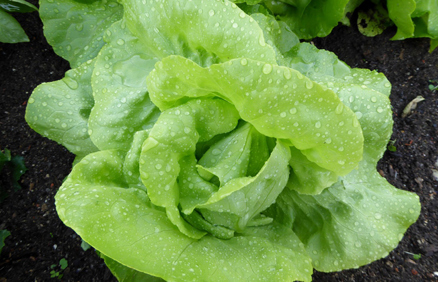Pesach: Maror on Seder Night

This article covers various halachic issues related to eating lettuce as maror on Seder night. Eating maror on Seder night: five practical questions and answers
Question 1: Can I eat any bitter food to perform the mitzvah of eating maror and is there a preference to Romaine lettuce?
Answer: Chazal tell us that we can only observe the mitzvah of eating maror on five specific types of vegetables mentioned by the Mishna (Pesachim 2:1), which are: "chazeret (=lettuce), olashin, tamcha, charchavina, and maror." (for a precise identification of these vegetables, see the booklet Merorim by Prof. Zohar Amar). There is a preference for lettuce, even if it is more expensive, for several reasons: (1) the main mitzva is to eat chazaret since it is the first type listed by the Mishnah (2) the way it grows is similar to the Egyptian enslavement process, soft in the beginning and hard and bitter at the end (Pesachim 39b, Shulchan Aruch OC §473:5, Mishna Berura, ibid.).
Question 2: Does the lettuce need to be bitter?
Answer: Although some poskim write that one should eat the lettuce when it is bitter, most poskim do not require it to be bitter. The mitzvah is to eat one of the vegetables mentioned called maror, and lettuce is preferable for the reasons mentioned above (Peri Chadash, §473:5, Sulchan Aruch HaRav §473:30).
Question 3: Is it possible to perform the mitzvah of eating maror on lettuce grown hydroponically?
Answer: The prevailing opinion is that it is possible to perform the mitzvah of eating maror lechatchila regardless of its method of cultivation, just as one can observe the mitzvah of eating matza on wheat grown in an unperforated pot. Even according to the posekim who maintain that the blessing for hydroponically grown lettuce is shehakol, one can avoid saying the blessing by relying on the hamotzi recited before eating matzah (see Torah VeHa'aretz VI p.364, Mikra'ei Kodesh Harari-Pesach p.457 quoting Rav Shaul Yisraeli and Rav Mordechai Eliahu).
Question 4: When taking terumot and ma'aserot when there is a doubt from lettuce meant for maror, do I need to give ma'aser rishon to a Levi?
Answer: Some posekim maintain that for rabbinically ordained mitzvot like maror today, the limitation of a "mitzva haba'ah be'aveira" (mitzvah performed in a forbidden way) does not apply. For this reason, if ma'aser rishon is not given to a Levi, even though this constitute stealing from a Levi, it still does not pose a problem when eating the maror. However, there are those who believe that maror is similar to matzah, in that it must be the full property of the person performing the mitzvah. The Mishnah Berurah rules in this vein (§473:33). According to this approach, if a person is supposed to give part of his lettuce to a Levi but fails to do so, some of the maror that he will eat will not be his, so he will not be able to perform the mitzvah of eating maror. For this reason, ma'aser rishon should be given to a Levi from the lettuce that will be used for maror, and this is optimal also when terumot and ma'aserot are taken due to doubt (this is the ruling of Rabbi Ya'akov Ariel, Emunat Itecha 33, Nissan 5755; Halichot Shelomo, Pesach 7:22).
Question 5: Is it possible to buy lettuce that grew in an open area, wash it with quality cleaning agents, and eat it without checking the leaves?
Answer: Like with all leafy vegetables, soaking lettuce grown without halachic supervision is insufficient. It is imperative to also perform a visual check to see that there are no insects visible to a healthy, human eye in a well-lit area.
The reason is that every vegetable or fruit that is generally infested must be checked visually by the naked eye to ensure there are no insects, as Shulchan Aruch (YD §84:8) rules:
"כל מיני פירות שדרכן להתליע כשהם מחוברים, לא יאכל עד שיבדוק... שמא יש בו תולעת" - "All types of fruits that are generally infested when they are attached to the tree, one may not eat until he checks … for it may have a worm inside it."
Lettuce grown in an open field is one of the crops we are obligated to check before eating to ensure there are no insects, and we need to remove any insects we find from its leaves. At times it is also necessary to throw away leaves with signs of tunneling left by leaf miners, since they might still be present within the leaf. The posekim rule that when there is an obligation to examine for insects, the examination has to be an inspection of 100% of the product to the point that we can safely say that no insects were found upon visual inspection.
Experience shows us that even after rinsing in water and the best cleaning agents, lettuce grown in open fields remain infested with many types of insects. For this reason, it is clear that even after rinsing or soaking, we still need to inspect the leaves.
Note that even when it is difficult to see the insects, since they are camouflaged with the leaf or because of poor lighting conditions, it is still necessary to inspect for them (Chochmat Adam §34, Binat Adam 49-50). This examination should be performed by G-d fearing individuals with good vision (Mishnah Berurah §473:42). Even if it is very cumbersome to examine the lettuce, there are no loopholes (see Halichot Shelomo, Pesach 7 §23; Piskei Teshuvot §473:18). For these reasons, throughout the generations some posekim preferred types of maror that do not involve intense examination, even if they were less preferable to lettuce from a halachic perspective (Mishnah Berurah, ibid.).
In conclusion, it is preferable to buy lettuce for maror from reliable companies that market insect-free products that are also free of pesticide traces, and not rely on rinsing lettuce grown in open field.
